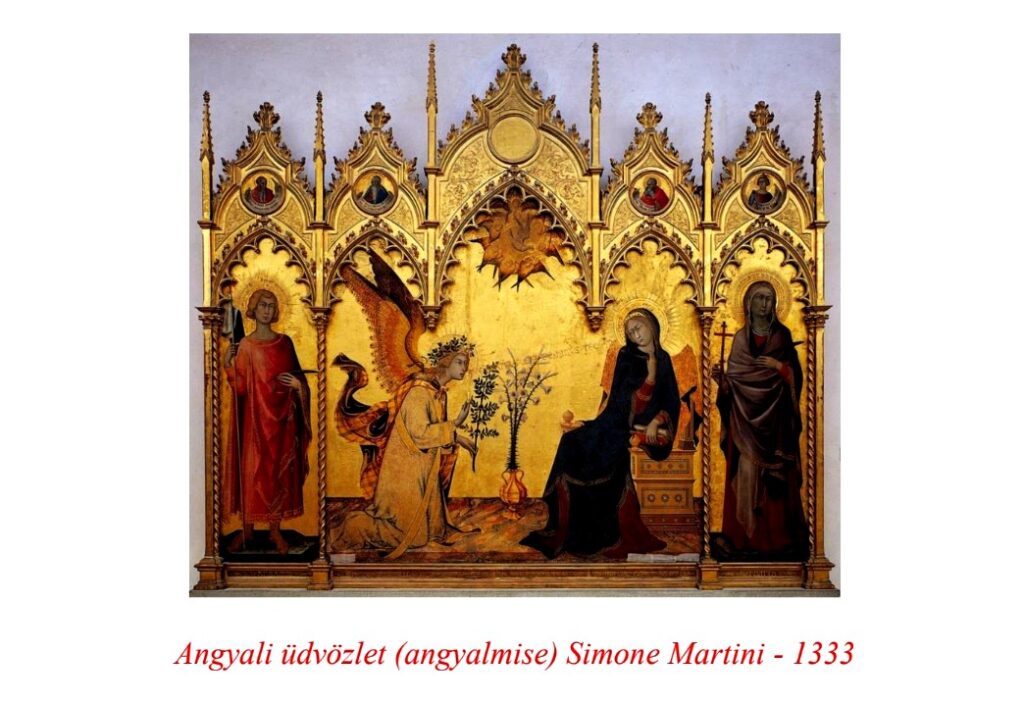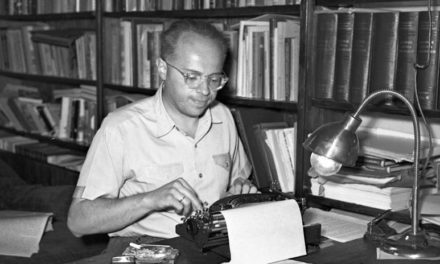"A nation that does not know its past does not understand its present, and cannot create its future!"
Europe needs Hungary... which has never let itself be defeated.
Advent, the period of waiting, is the four weeks before Christmas. We are waiting for the birth of Jesus Christ. In Hungarian families, Advent is complemented by two popular customs, the making of an Advent wreath and an Advent calendar. The latter is more for children, for children. The Advent wreath is only available on the 19th and 20th. spread at the turn of the century, it became known when it was first made by an evangelical minister, originally from pine branches, with four candles on it. Today, candles with many different wreaths and many different colors are used. But traditionally, three purples (the colors of repentance) and one pink (the color of joy) express the message of the Advent lights.

We light
the two purple candles on the first two Sundays, the pink on the third, the day of joy The four burning candles represent the full light, which symbolizes the birth of the Savior, Jesus Christ
.
The first Advent wreath was made in 1839 by Lutheran pastor Heinrich Wichern in a children's home.
then placed on the two-meter-diameter wooden wheel .
The advent calendar of German origin has spread in Hungary since the beginning of the 20th century. It is a small box with 24 numbered, closed windows. Children can open the first window on December 1, and a new one every day from then on. The hitherto unknown gift inherent in it brings joy to the children. The last window, revealed on December 24, represents the greatest joy, the birth of baby Jesus.

The Hungarian Christmas cycle lasts from the beginning of Advent to Epiphany.
The beginning of Advent in 2023 falls on December 3, the Sunday when we lit the first candle, and the last day is December 24, Sunday. The Christmas holiday season in 2023 began on November 30, St. Andrew's Day, which is the time of pig slaughtering in the peasant world. This determines the comfort and eating habits of the holidays. Christmas is a holiday of love for Christians and Christian peoples. Over the centuries, the world of traditions has also changed in the Carpathian Basin. Differences can be found in each landscape unit, and also in Eastern and Western Christianity, as well as in the Christian religion. However, the point cannot change! At Christmas, every family celebrates the birth and earthly incarnation of Jesus Christ. For Catholics, the highlight of Christmas occurs at midnight on December 24, during the midnight mass, when Jesus Christ, the Savior, is born. On December 24th, the Reformed take part in a service, and then on December 25th, the sacrament is the highlight of the holiday. For many Hungarians, one of the most beautiful works of literature is the two lines of Endre Ady's poem Christmas: "The Messiah used to bring happiness to my lovely little village./ Young and old go to the church in a long line;/ in my lovely little village, thanksgiving they give, to the God of the highest.”
Hungarian folk customs
Chanting
Chanting is the performance of rhymes, poems, and good wishes at houses, which are actually texts asking for donations. Advent began with these group visits to the village. The term chanting is the most common, but it is also known as angelic comfort, chanting, mendicating, and paszízás. The singers visited the houses of the settlement according to age groups. The children, boys and girls, started chanting in the morning hours, the young people in the afternoon, and the older people in the evening hours, they went from house to house singing, announcing their good wishes, accompanied by poems and rhymes. They only started singing when they got permission from the family. The oldest song begins with Csordapásztorok..., which we already know from a church collection created in the middle of the 17th century. The other best-known hymn is Pásztorok kekeljőjn... it is included in an 18th-century collection. The melody of the angel... was heard most often from Heaven. Transylvanian chanting was very diverse, as the rich traditions of the Székely, Kalotaszeg, Bukovina, and Gyimesi peoples were different in almost every village. However, a multi-day dance was typical in Transylvania, which had a strong tradition especially in the villages of Kalotaszeg.
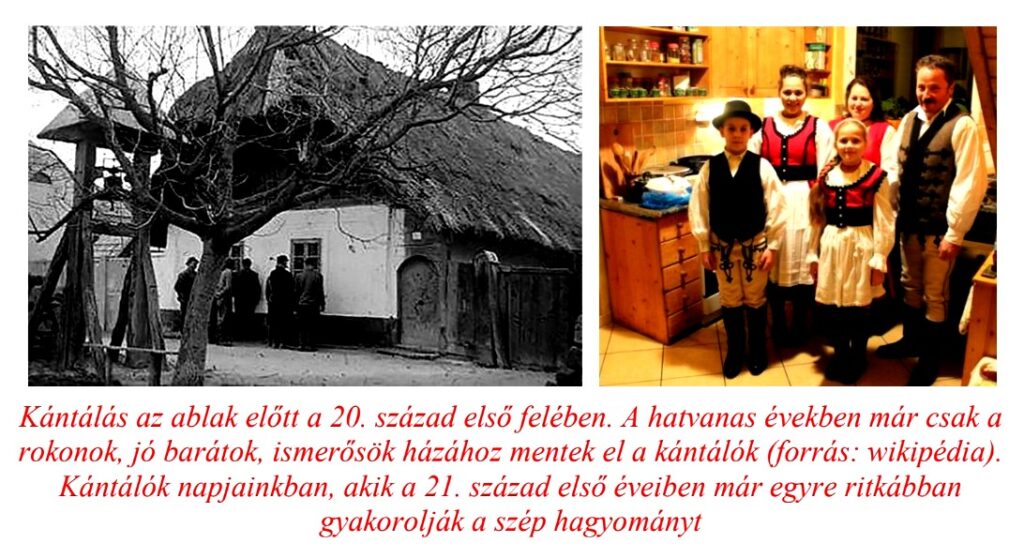


In the Hungarian language, the word Christmas has several explanations. The Bulgarian word kracun (step, step, step) invented and forced in the 1970s is a product of socialism. Our term for Christmas is not of Slavic origin, just because none of the surrounding Slavic peoples use it. The Catholic Church derives it from the Latin word creatio (creation), which also appears in New Latin languages. For example, calatio (convection) comes from the original Latin term. For us Hungarians, the word kerecsen or kerecseny corresponds to the word Christmas, not only from an emotional, historical, ethnographic point of view, but also based on a linguistic approach. The old Hungarians used to hold the falcon flight, i.e., flying in a cage, at Christmas, on December 25. And the meaning of kerecsen is black, which refers to the shortest, darkest day of the year, which is followed by light. The Kerecseny Festival of Lights is already known from the history of the ancient Hungarians.

Epiphany, the end of the Christmas cycle in Western Christianity - as every year - falls on January 6. Christmas always falls on the same days (December 24-25-26). In contrast, Easter is a moving holiday. The Eastern Christians (Orthodox), who remained with the Julian calendar - that is, they did not switch to the Gregorian calendar - celebrate Christmas on January 7, and Epiphany 13 days later. On Epiphany Day, we remember the Eastern Wise Men and the Three Kings, which is one of the defining holidays of the church. Its meaning is the ceremony of sanctifying water, the closing day of the Christmas season. (Nowadays, for many, all that is left of this is that they take down the Christmas tree.)
Rora's
Morning mass, which is also called the sweet mass, the angel mass. Its meaning comes from the Latin word "dew". The villagers went to Rorate from the first Sunday of Advent until the first day of Christmas, which was held every day in Catholic churches. In Transylvania, all sheds, barns, cages, doors, and windows had to be closed during the mass, because the witches could then harm the animals, i.e. cause harm.
 Santa Claus
Santa Claus
In recent decades, the names of the December holidays have been confused even in the minds of people of good faith. Advent, Santa Claus, Father Christmas, the birth of baby Jesus, Christmas, the Christmas tree festival, giving gifts, mean almost the same thing. Below, by describing the harmony of Hungarian Christmas, if only in outline, let's try to put the listed holidays in their place.
Advent. The word means "arrival" and the 24-day period of "waiting". Its first day is the fourth Sunday before Christmas. We light the first candle then, which falls on the end of November or the first day of December. (For children, we can best understand the essence of Advent with the calendar consisting of 24 small windows.)
Santa Claus. It originates from the name of the bishop of the city of Myra in Asia Minor, St. Nicholas. It is a symbol of selfless, "secret" gift-giving when the children's dear Uncle Santa arrives. December 6 is associated with this holiday.
Santa. It is a communist invention that denies Christianity and wants to erase even the name and memory of St. Nicholas. Santa is not Santa!
Christmas. The day of Jesus' birth, December 24, and the following two holidays. At Christmas, the "gift" is not brought by Santa Claus, and especially not by Santa Claus, but by baby Jesus. The greatest gift is the birth of the Savior himself.
Fir festival. It is a communist confusion similar to Santa Claus, to erase the essence of Christmas, even the word Christmas itself - the most beautiful mystery of European Christian people - from our consciousness. Today, in the "overdeveloped" western states, the situation is even worse, Christmas belongs to the category to be persecuted.
Big Christmas
Nagykárácsony is a settlement in Fejér county. It owes its national fame to its name. Before Christmas, the holiday postcards sent from here have a special significance, which is validated by the Christmas post office stamp. Student groups, families, and collectors visit Nagykáracsony village during Advent to make the celebration of the birth of Jesus more meaningful and memorable.
Kunos settled the area in the 13th century. In 1702, the village was already referred to as Karácsonyszállás. The name refers to the fact that after the summer grazing period, the shepherds gathered here for winter accommodation and celebrated the successful year at Christmas time. This is how the Pre-housing became the Christmas Housing. However, the celebration took place with the observance of Christian religious ceremonies - honoring the birth of Jesus - which was checked by the manor administrator. The pastoral peoples were happy to keep the pastoral (nativity) folk customs. The current name of the village, Nagykárácsony, was formed in 1952, when the people of the farms and wastelands were forced to move to the central settlement. The fact that the communist leadership at the time did not change the name of the village was surely an own goal on the part of the Rákos!
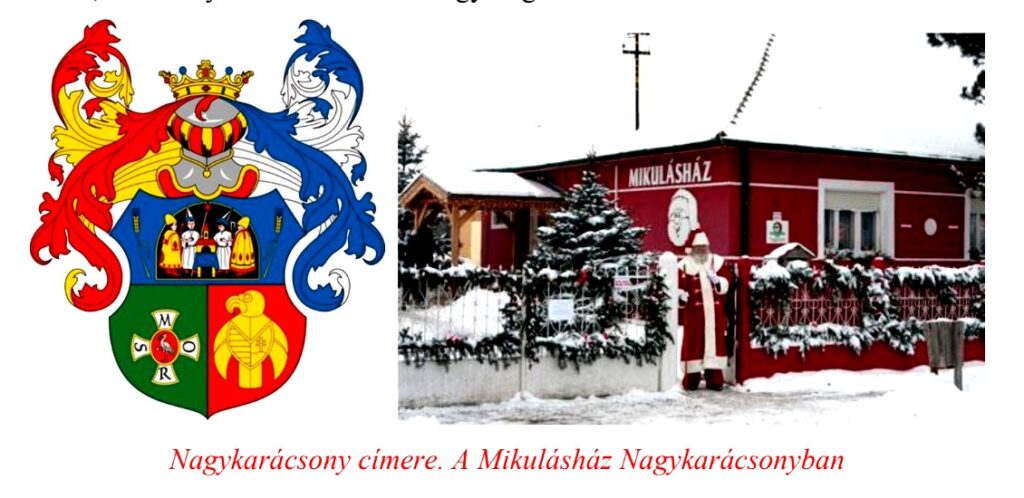
Hungarian folk tradition has always celebrated St. Nicholas' Day, Santa Claus, on December 6, never the Soviet distortion, Santa Claus. This only became "fashionable" during the Rákosi-Kádár period. The goal was to make people forget the role of the church and the name and history of St. Nicholas, who is accepted and highly respected throughout the Christian world (Eastern and Western).

Santa Claus in Chains and his entourage of crampons with pitch-black faces chased the evil spirits away from the house by rattling chains and making noise. Entering the house, this Miklós threatened the bad children with his scary appearance and distorted voice. He also gave a present, but the appearance of Santa Claus was more characterized by the "beating" with a stick. The use of virgács also came into use at that time. Small children were afraid of it, and therefore this custom was banned from the end of the 19th century. He was replaced by the smiling, gift-giving Santa Claus in a beautiful red and white fur long coat. This Cloaked Santa appeared for the first time in the cities, the scary Santa figures remained in the villages for a long time.

The story of Santa Claus
The name of Saint Nicholas is known all over the Christian world. The Saint of Myra is highly respected by both Eastern and Western Christians. The sixth of December is the feast of St. Nicholas. The day the bishop died in 342 in Myra. Born in Anatolia in 245, the child soon became an orphan, but inherited a huge fortune from his parents. The young man who chose the priestly life, the monastic world, was elected bishop in Myra, which was thanks to a lucky coincidence. After the death of the previous bishop, the bishop selection board made the decision to elect the person who entered the church gate first thing in the morning. This man was young Miklós. No one else could have been more suitable for this position than him.

Bishop Miklós used his wealth for charitable purposes, thus becoming a role model of giving love. He is also the patron saint of sailors, merchants, fishermen, pilgrims, and girls getting married. He held the office of bishop in Myra for more than half a century, during which time he helped countless people with teaching, wise advice, money, and food. There are many legends about his life, and among other things, the role and personality of Santa Claus is also related to such an event.

It happened that one of Miklós' impoverished neighbors had three beautiful and young daughters. In his final desperation, the father had already come to the decision to use his daughters in order to improve the fate of the family. He was about to send them out into the street, when Miklós, learning of the father's decision, secretly threw so much money through the window into the house of the girl's family at night that he saved the family from shame and deprivation, and was even able to get the girls happily married off. This was followed by many similar actions, and Miklós spent his entire life in this spirit.
This gave rise to the Santa Claus trip, which can already be classified as a folk tradition. The name Mikulás is the nickname of the Slovak Miklós. A person with a big beard, fur, red cloak, hat, and boots appears in the culture of almost every nation, who has become a symbol of gift-giving.
Santa Claus - Santa Claus on the 20th-21st. century
The figure of St. Nicholas merged with the Christmas holiday. December 6 is already part of the Advent holiday cycle, and Santa Claus, the gift-giver, is a popular Christmas figure. That is why, especially in the 20th century, certain cultural circles - primarily the great powers that enforced special rights for themselves - distorted the true meaning of the mystery of Christmas through the person of Santa Claus. The Soviet Union and the United States were at the forefront of this.
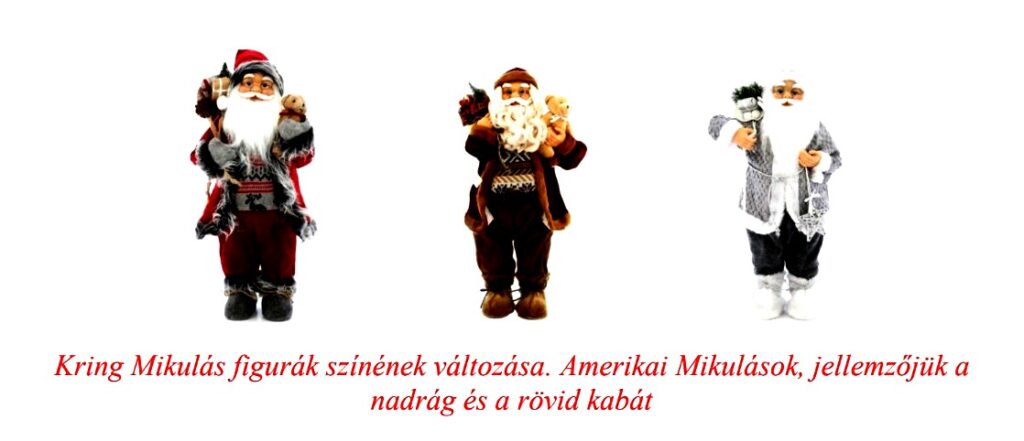
Saint Nicholas was highly revered in Tsarist Russia. After all, in cities and villages, the names of their churches, their ecclesiastical art, and the teachings of the priests place St. Nicholas in the center. It is also no coincidence that tsars also bore the name Miklós. The Byzantine (Eastern Christianity) customs had a strong influence even in Hungary, primarily through the person of the helper saint. After all, from Gyergyószentmiklós in Transylvania to Kun- and Törökszentmiklós, Fertőszentmiklós to Liptószentmiklós in the highlands, about thirty settlements and hundreds of churches bear the name of Saint Nicholas. Precisely for this reason, because Miklós was so deeply ingrained in the consciousness of the European peoples, the communist system even tried to forget his memory. This is how from the 1950s (in the Stalinist regime) Santa Claus became Santa Claus (the Russian Gyed Moroz, i.e. Father Frost), and Christmas became a Christmas tree festival.

Since the 1950s, every schoolchild in our country has sung the popular children's song Hull a pelyhes behér hó,/Come dear Santa./Every child is waiting,/the sound of a cheerful song is heard. Its author is Ernő Rossa, who is known for everything from the Lenin song to the Workers' March to Harsan a kürtszo and many other inspiring communist songs. Ernő Rossa talentedly served the Soviet system with well-known movement songs for children and young people.
In America, Santa Claus is the name of Father Christmas, which is already a distorted version. This name was spread by Dutch settlers in their new homeland at the end of the 18th century. The Protestant Dutch still called him Sinter Klaas (Saint Nicholas) and dedicated their Christmas holiday to him, which was later distorted in American public life to the aforementioned Santa Claus. Already in 1809, the story was born, according to which Santa Claus, who rides on a flying sleigh, brings gifts, and has a big beard, became a favorite figure of children. This custom took strong root primarily in the Anglo-Saxon countries and Protestant areas, which was also appropriated by the business life and the money-minded system.
The overly ornate, rather kitsch Christmas lighting you can see in the movies is about money and the value of the gift, not about the essence of Christmas. From Santa Claus to Santa Claus, the "tear-touching" American Christmas - especially his film creations - wreaked the same havoc on people's souls as the Soviet Santa Claus. The sleigh drawn by reindeer flying through the air, on which Santa Claus brings the gift down the chimney, also spread through American films. However, let's add that the Protestant customs of the Northern European immigrants come to life in this.

In the majority of socialist countries, the day after Christmas was even deleted from the calendar as a public holiday. If it was possible and necessary to celebrate, then Stalin, born on December 18, was placed in the place of Santa Claus and Jesus. In our country, the traditional Christmas could be celebrated in the original way from 1988. In most schools, nativity scenes could start again at that time. The fight over the ideological content of the names Santa Claus and Santa Claus has not ended even today. Santa Claus is a product of the ideology of the Soviet system. Although those who deny this point to the fact that the name Gyed Moroz /Fagy apó/ existed long before the communist era. This is true, but it is also true that behind the name Mikulás is the figure of Saint Nicholas, and he had to be eliminated from the consciousness of school children. This was achieved in the half century after the war, and when one school or another teacher dares to stick to the name Santa Claus again, they are accused of forgery.
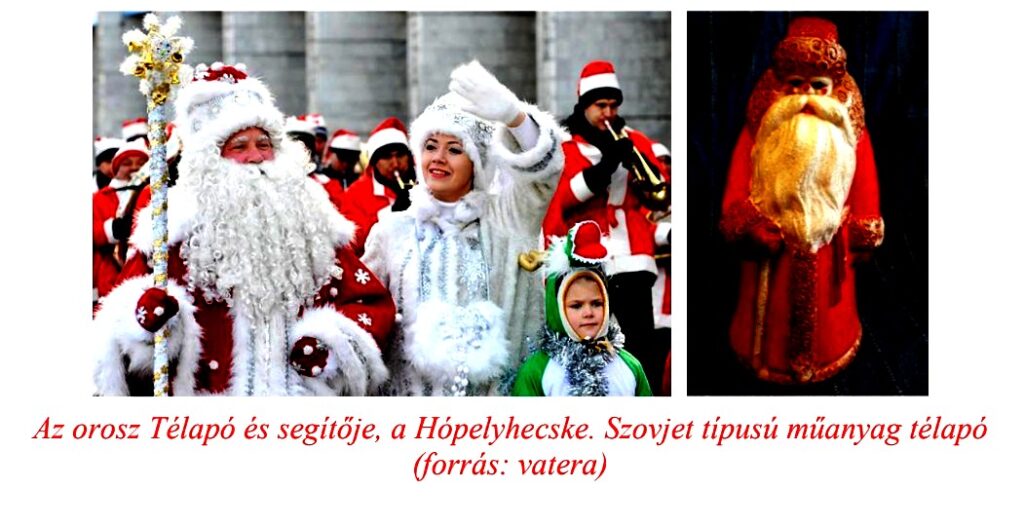
A special mention must be made of the "real Santa", the Finnish Joulupukki, which means "Christmas goat" in Finnish. The name is not even a hundred years old, as the Finns first heard about it in 1927, on a radio program. Joulupukki lives in Rovaniemi, Finland. The settlement is located in Lapland. It even has a mailing address where children can write to Santa Claus about what kind of gift they would like to receive. The Finnish Christmas goat was originally a well-known figure of Nordic pagan myth, and also a symbol of child punishment. This negative role was only changed to the kind Santa Claus in 1927. The figure and popularization of the Finnish Santa Claus has become an integral part of business life. He travels by plane to every country to which he is invited, of course he undertakes his appearances with lucrative contracts. In recent years, the Finnish business has reached a low point, which was caused, among other things, by the virus and the Islamic threat.
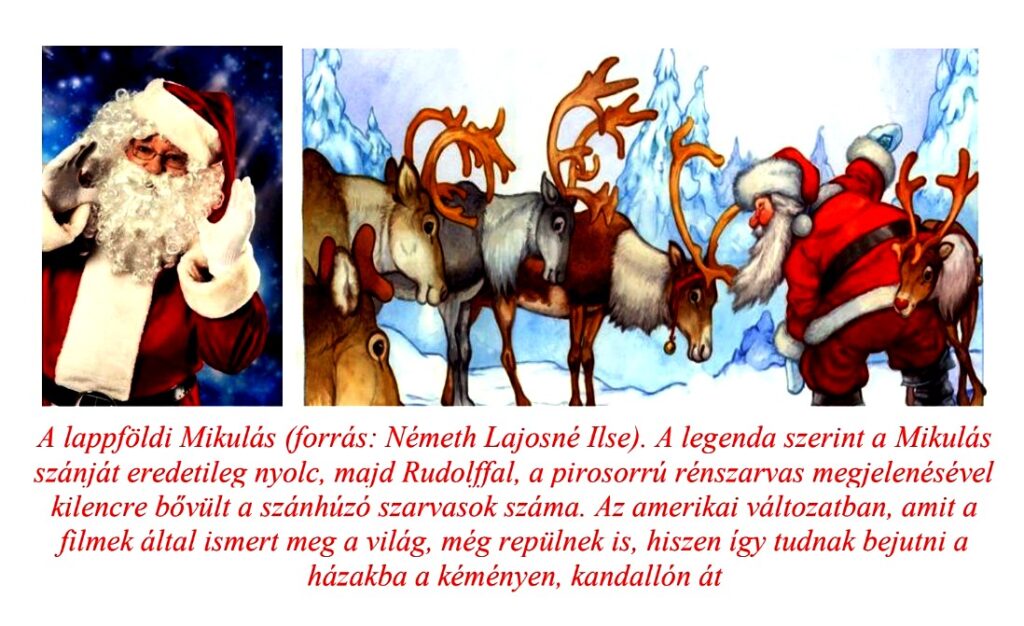

The popularity of Santa Claus, the figure of the kind, gift-giving, big-bearded old man in red clothes did not stop at the borders of the Christian world. Perhaps not with similar content and religious background, but Santa Claus is known and celebrated in Japan, China and Morocco, for example. The latter is interesting and unusual, since it is an Islamic country.
Luca day, lucasing
Luca was the day of the winter solstice before 1582, until the Gregorian calendar replaced the Julian calendar. Luke's day, December 13, was followed by the longest night of the year, when Saint Luke "transformed" into a witch. Luca's day was the day of girls and women, and on this day they were not allowed to work, but this day also meant increasing the egg yield of the hens. In the peasant world, almost all of the ancient traditions - including the feasting - served to produce the next year's food, meat and wheat. On Luca's day, the young boys visited familiar houses and families, and in exchange for their good wishes, they expected a donation from the family. (If they didn't get this, it was rather in a humorous form, but they cursed the stingy householders.)
Many traditions and customs are associated with Luca's day. These include waiting for the Light Fairy, as well as love predictions, such as cooking Luca dumplings. The most well-known customs are Luca chair making, Luca garlic and Luca wheat. Making Luca pumpkins was also known in Transdanubia, not only in the Anglo-Saxon countries. The greatest importance, the tradition of the Luca day, expanded with spectacular, colorful elements, was developed in Sweden.

The Luca chair can only be carved by men, which was originally a three-legged sitting occasion. They started work on Luca's Day, and adjusted it a little every day until December 24. After the 12 days - which meant the 12 months of the year - the men took the chair with them to the midnight mass. Standing up, in the church, they could see who the witch was in the village.

Hatching of Luca wheat should begin on December 13, when wheat grains are planted in a bowl. Germination took place near the stove or oven to keep it in a warm place. The wheat sprouted on Christmas Day was used to decorate the Advent altar in the church, on the other hand, it was used to decorate the house, and the next year's harvest was also "read" from it.
The girls also followed a custom on Luca's day. They cooked dumplings, in each of which they hid the name of an unmarried man from the village. Based on the name of the man hidden in the first dumpling to rise to the top of the water, they knew which of the girls would get married in the following year.
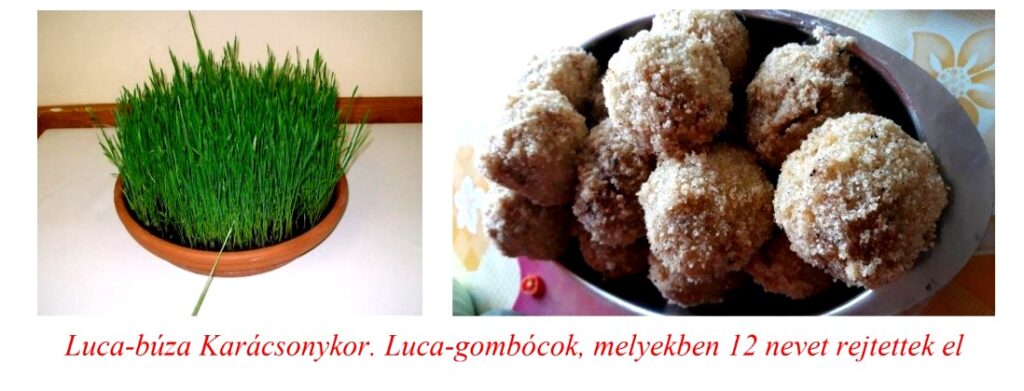
Nativity
The nativity scene best expresses the mystery of the Savior's birth. This shepherd's play with several actors was known in almost every landscape of the Carpathian basin, but its richest versions can be seen in Transylvania. The custom is named after the biblical city of Bethlehem. The essence of the game is that the angels wake up the sleeping shepherds and send them to Bethlehem to look for the Savior born today. At the end of the musical and poetic game, the shepherds hand over their small gifts and say their good wishes.
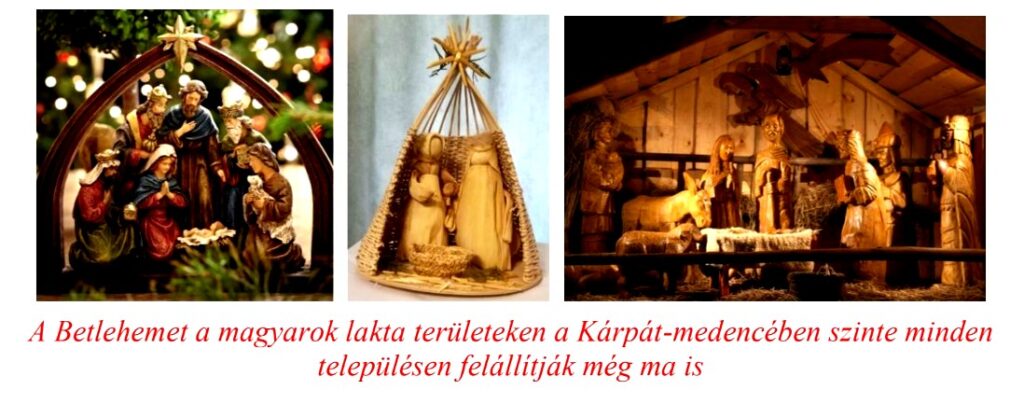
Even on Christmas Day, the purpose of folk customs is to drive away evil, harmful spirits by making noise, wearing animal skins, costumes, and masks. This is also when the nativity scene takes place. This game was originally performed by children in churches, and later at families' homes. Animals were often included in the nativity scene, and the child Jesus was depicted with a live baby. The characters - shepherds, angels, Mary, Joseph - act out the biblical story about the birth of Jesus, and then give their gifts and wishes. After that, the family entertains the nativity scene.
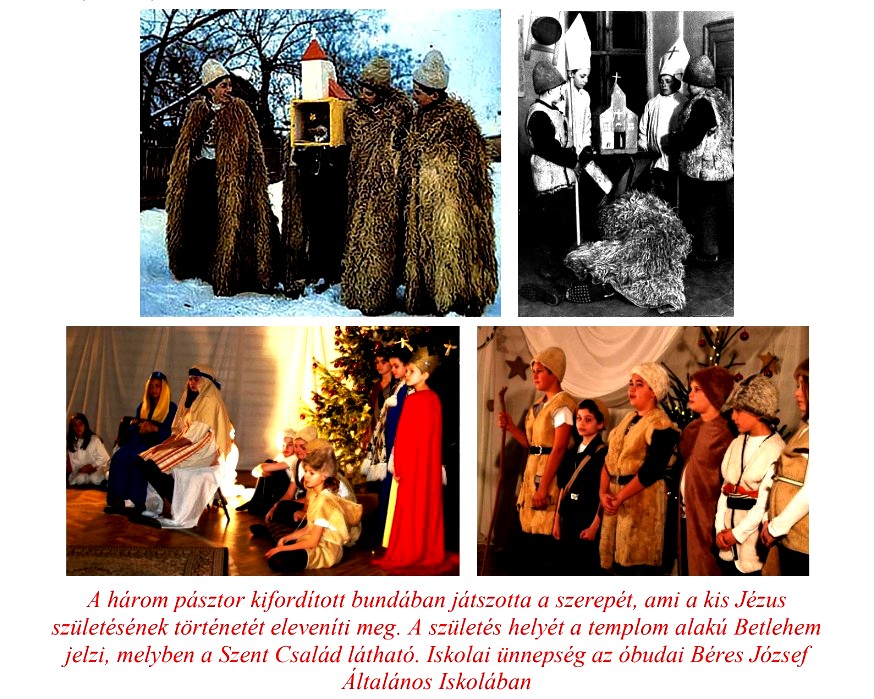

The secret of Bethlehem
The place of Jesus' birth can be linked to the city of Bethlehem in the West Bank, today in the territory of Palestine. The ancient settlement is located only ten kilometers from Jerusalem, which belongs to Israel.

The story of Christmas began in the city of Bethlehem. The Eastern Church links the place of the birth of the God Child to a cave, and the Western (Latin) Church to a stable. This beautiful story, which is connected to the essence of Jesus' teaching, the support of the poor, the sick, children and the downtrodden, has been deeply embedded in the consciousness of the Christian man for two thousand years. Among the four evangelists, Márk and Lukács do not even mention the birth in their writings. Matthew, on the other hand, wrote: "During their stay in Bethlehem, the time of childbirth came. Mária gave birth to her first-born son, wrapped him in swaddling clothes and laid him in a manger, because there was no room for them in the inn." In addition to Jerusalem, Bethlehem is also considered the city of David by the followers of the Old Testament, from which it "naturally" followed that the Savior could have arrived on earth in this city.
The birth of Jesus was a joy not only for the poor shepherds, but also for the rich, as well as for the wise men from the East. This is how the Gospel of Matthew describes the birth story. “The star they saw in the east led them until it finally stopped over the place where the child was. They were very happy when they saw the star. They entered the house and saw the child with his mother Mary." The reality, which according to some researchers differed in many ways from the romantic story, is quite different. According to them, it could not have happened, for example, that Mária and Óssef could not have found suitable accommodation for a mother about to give birth in Bethlehem. After all, the inhabitants of the small town knew well who József was, and they even knew that he was a descendant of David. The mystery of Christmas is most beautifully illuminated by the Gospel quote (Jn 3:16): "God so loved the world that he gave his only begotten Son, that whoever believes in him should not perish but live forever."
Authors of Silent Night
Josef Mohr , the simple Austrian priest, and Francz Gruber met and became friends in 1818. The Austrian residents of the area around Salzburg, hit by the Napoleonic wars, lived in abject poverty, often almost starving. This was also the case in Obendorf, where even the organ of the village's small church broke down on Christmas Day. The priest of Obendorf, Josef Mohr, asked his friend to find a melody for the text he quickly wrote, so that the people of the village would not be left without Christmas spirit. Gruber did this, and Josef Mohr, having no other instrument than a guitar, played the melody of Silent Night on it and sang the lyrics along with it.


The birth of Christmas
The first Christmas was celebrated in Rome, the capital of the Roman Empire, on December 25, 336. That this could happen was decided by the bishops at the First Council of Nicaea held in 325. It has been known for centuries that Jesus' birth did not fall on December 25. On this day, the pagans presumably celebrated the birth of light, the Sun. (In the Roman world, the winter solstice - the period between December 17-25 - was the festival of Saturnalia, when people paid tribute to the god of agriculture. Christmas is connected to these days, which were also a celebration of gift-giving and joy. The Romans it was decorated with green plants and lamps, which may have been the origin of the symbol of Christmas /the green pine tree/.) According to Christians, Jesus is the light itself, since he is the one who defeated the darkness. This is how the person of the Savior connected the pagan and the Christian holiday, which then became one of the biggest, but certainly the most intimate, family holidays among us Hungarians.

Martin Luther's Christmas
According to some researchers, the first Christmas was celebrated in 521 in York, England. After that, however, more than a thousand years had to pass before the first Christmas tree was erected. It was the reformer who caused the schism, Márton Luther, who, according to legend, greeted his own child with a pine tree in 1536. The Christmas tree - the tree in the middle of the Garden of Eden - is a symbol of God's acceptance of all people into Paradise, regardless of whether they have done good or bad in their lives. It is not where you belong according to your origin, religion, or gender, but the fact that you are God's creation.
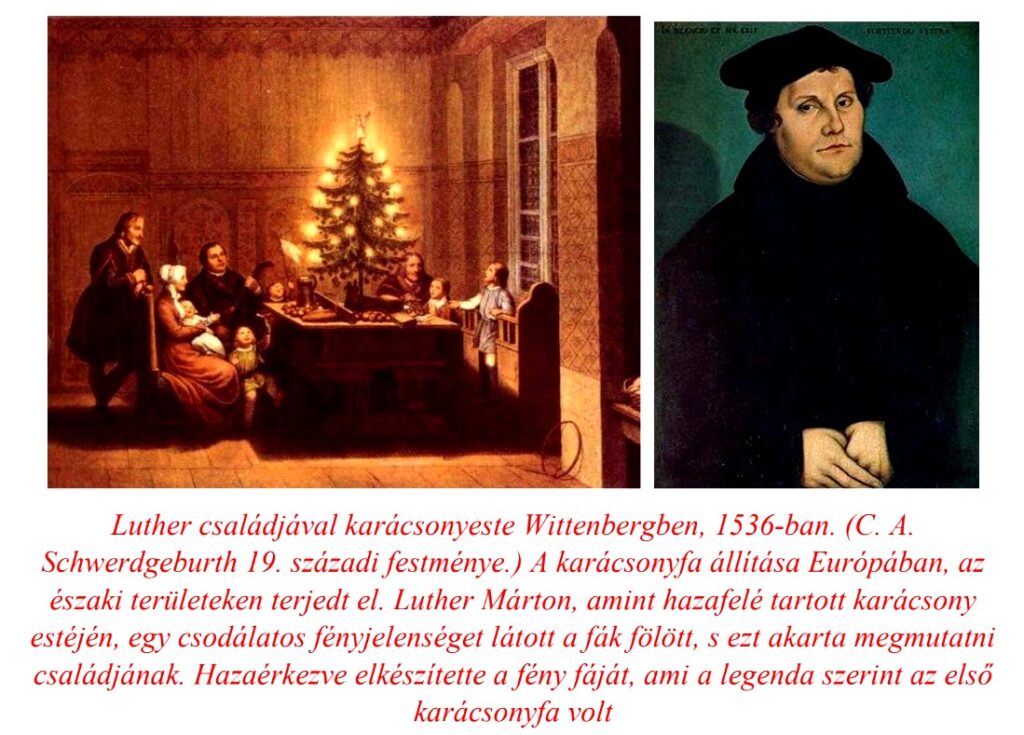
Teresa of Brunswick
The first Christmas tree in Hungary was erected by Teréz Brunszvik in 1824 in Pest, according to other sources, in Martonvásár. However, the Bezerédy and Podmaniczky families also played a major role in introducing the Christmas custom. In Hungarian literature, Mór Jókai spread the knowledge of the Christmas tree when he published his story The Beggar's Child in 1866. (It is worth noting that the concept of the Christmas tree, or more precisely the "Christmas tree", was already known in the 17th century. However, this was not the pine tree representing the birth of Jesus. It can be proven that in many areas of Transylvania, landowners distributed firewood to poorer families at Christmas. )

Christmas curiosities
The Christmas tree claim was arguably first made in Germany. The beautiful custom soon took root in Vienna, where it was spread by a family that moved from Berlin in 1814. In Europe, however, this "strange custom" became common only three decades later, when Queen Victoria made it fashionable. It so happened that in 1846, in a drawing published in a newspaper, the Queen of England, the ruler of the British Empire, was depicted with her family standing next to a decorated Christmas tree.
If anyone else had done this, this Christmas fashion would not have spread almost like wildfire in the Christian world. But the person and example of the Queen of England was a landmark in the territories dominated by the Anglo-Saxons, who had already become a factor in world domination. It can be said of Queen Victoria that the sun never set on her empire.
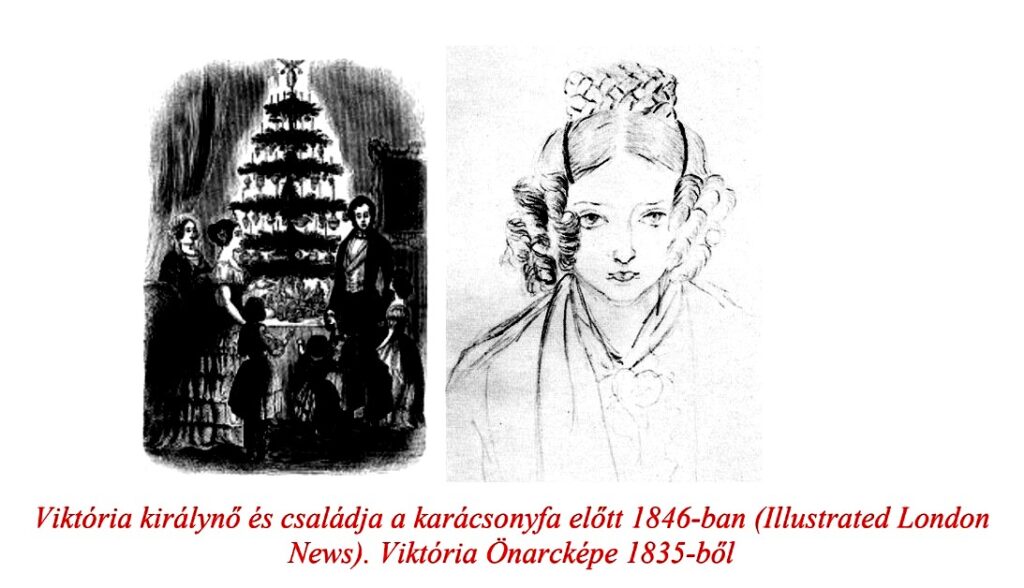
A beautiful event and initiative of Christmas is linked to Saint Francis of Assisi who lived in the 13th century. Thanks to him, families started singing Christmas carols in their homes and churches.
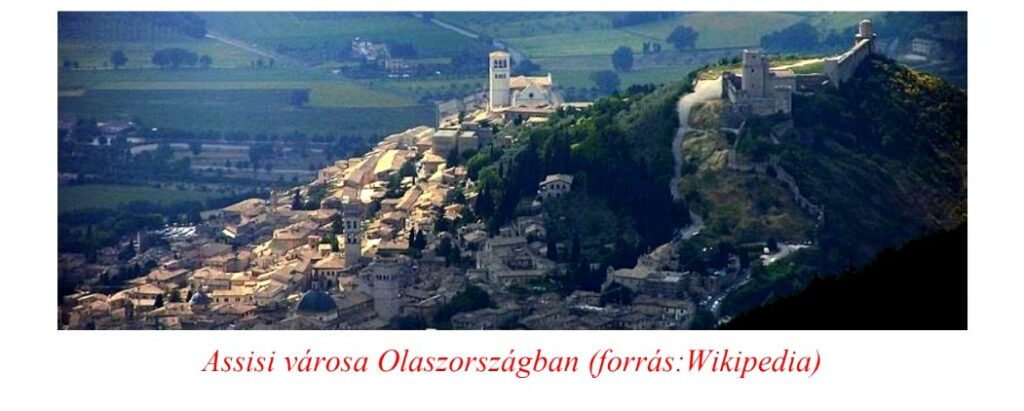
This custom was passed on in the Nativity scene in the Hungarian-speaking regions. In European countries, many traditions of Christmas, also known here, are the 10th-12th. was formed in the century. For example, the gifting of tangerines, apples, and walnuts spread from France. The ancestor of bacon sugar was first prepared by the French and the Germans. However, given that a confectioner from Hamburg, Frigyes Stühmer, settled in our country, and he created the uniquely packaged candy that can be hung on a tree, salon sugar, we count it among the Hungarian sweets. If only because since the 19th century, it became a custom only in Hungary to include candy on the Christmas tree. Let it stay that way! (Unfortunately, it is already becoming a practice here, perhaps out of fashion, perhaps out of a love of convenience, to place the brown sugar in a bowl under the tree.)

Christmas, despite its simplicity, was associated with a number of events, material, artistic and religious elements that varied from age to age, people and country. These include the person of Santa Claus, candles, decorations, gift-giving, the colorful superimposition of family gatherings, church ceremonies, folk customs, and the midnight mass as the culmination of all of this.
Christmas Eve
Among Hungarians living in the Carpathian Basin and anywhere in the world, the most important and intimate day and event of Christmas is December 24, Christmas Eve. In the past, the festive dinner took place according to a strict order, which included the food on the festive table and the duties of the family members. For example, the farmer went out into the yard and shot into the air with a rifle to drive away the evil, harmful spirits. The hostess had to put all the food on the festive table, because she could not get up during dinner, so that she would have good egg-laying hens the following year. These customs, which vary by landscape unit, can only be found occasionally in villages that stick to their traditions. However, in many places, even city families stick to the food on the table. (It should be noted that in most Western European countries, families eat their holiday lunch or dinner on December 25.)
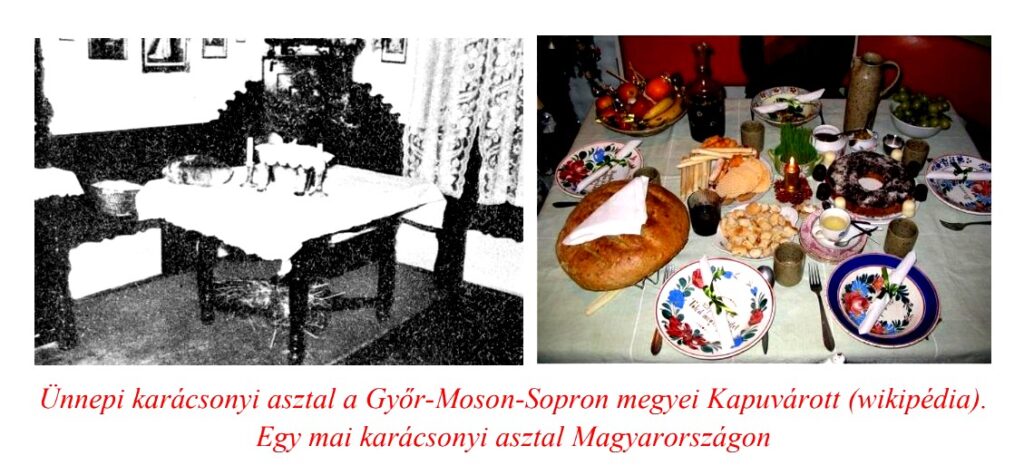
People living in the Christian culture of the world, even if they do not keep the old customs, Christmas is also about love and family togetherness for them. The gift is eagerly awaited on Christmas Eve, especially by the children, but on this day every member of the family receives a gift. Unfortunately, in the consumer society, gifting is the biggest source of income for business networks, which they make good use of. The advertising campaigns almost enslave the majority of people, and the expression of love is often the same as the purchased products, which has distorted the meaning of the Christmas mystery.
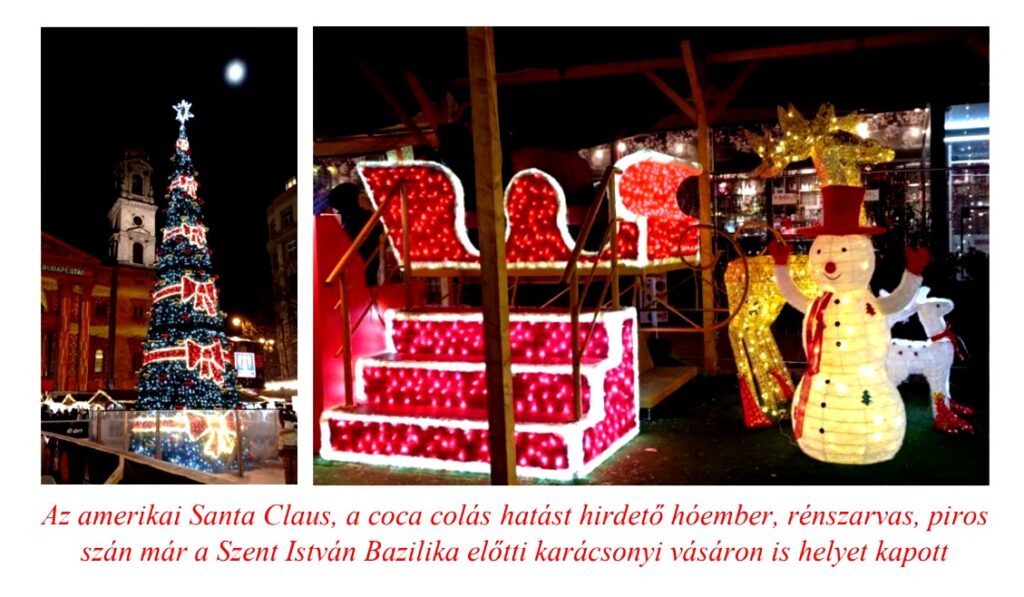
János Esterházy (1901-1957), one of the martyrs of Hungarian history in the 20th century, said on one occasion, when at best it was prison, at worst death. "Our cross is not the swastika, but the cross of Christ". And, thinking further about the above wise and brave statement, we can add that our star is the star of Bethlehem and not the red star.

In the past hundred years, Germany has dragged our country into the world conflagration twice. First in 1914, which ended in Trianon, and secondly in 1941, for which we then got decades of communist rule. In the 2020s, they will try again with us to give up our Hungarianness, our Christian culture, and our attachment to the family. There is a saying that Hungarian justice is three! Don't let this be true now, let's not follow the German example for the third time.
Breakfast, singing (December 26)
Regölés is probably the most ancient custom among all traditions, since our ancestors were the singers of the ancient Hungarian culture. The people of Táltos fell into ecstasy and recalled the mythological elements when they sang the Miracle Deer and recited the related rhymes.
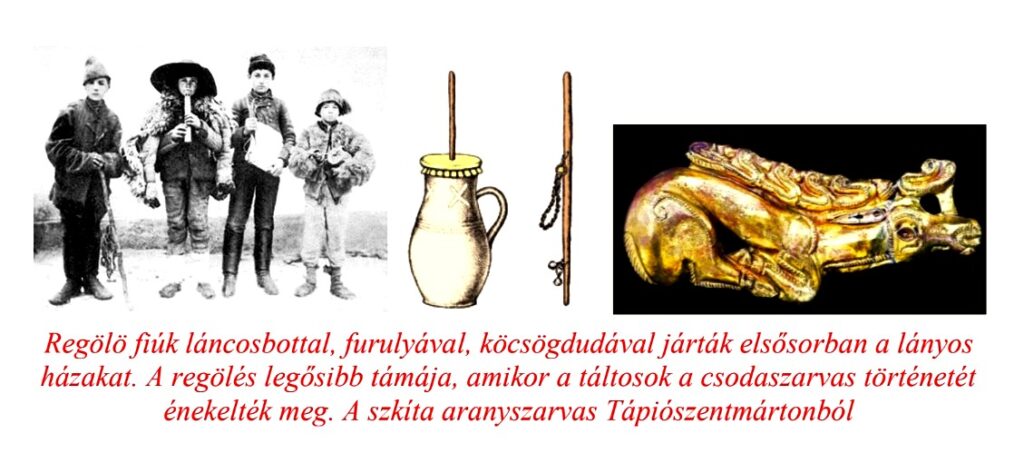
Later, the figure of King Szent István was included in their songs in a similar way. The welcome always began with the text "Get up, master, get up, God has come to your house...". The refrain "Haj regö rejtem, regörejtem" was always sung after each verse.
The custom of regölé is connected to the second day of Christmas, when the Stephens were greeted, recalling the name and figure of Saint Stephen. After that, the regös people visited the houses until New Year's Day, where they told the residents of the house their good wishes written in song and verse. The regölé, like other customs belonging to the Christmas circle, advocated abundance, a good harvest, and the search for a partner. However, some donations were expected from the family for the good wishes. The people of Regós, gathered in small groups, set out in pubs and fur coats turned inside out.
John's Day (December 27)
John's day is traditionally the day of consecration of wine. The wine consecration was performed by the priest in the church, who on December 27 gave his blessing to the rich grape harvest and the wine. The Hungarians attributed magical power to the consecrated wine, which they used to heal people and animals. The best-known example of this is when Tokaj aszu was available in pharmacies, where it was sold as medicine.

All Saints' Day (December 28)
All Saints' Day reminds us of King Herod's carnage. The news of the birth of baby Jesus reached the ears of the king of the Jews, who, fearing that the Savior would encroach on his power, slaughtered all boys under two years of age in his kingdom. However, the Holy Family fled to Egypt, so Jesus, Mary and Joseph survived. On the holiday held on December 28, we remember the little martyrs, the little saints. (You can read about the history of the little saints in the Gospel of Matthew.)
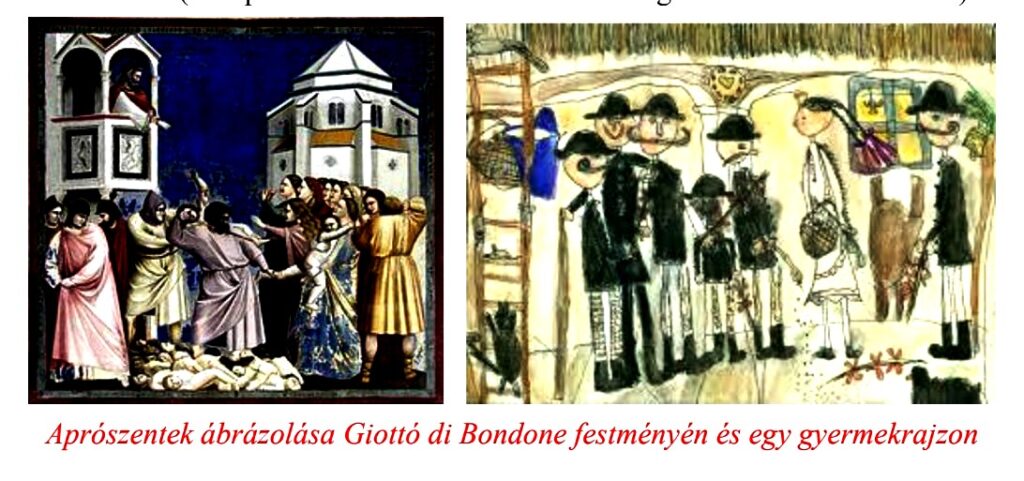
The Day of All Saints is a custom known and practiced in many European countries, which is expressed by caning. It is known in all regions of Hungary, which is also expressed by the words whipping, also known as suprikálás, odoricálás, clapúlás. During this, the boys went from house to house, and while they recited many good wishes and rhymes, they berated the girls. Originally, boys were beheaded, which refers to the martyrdom of the boys in Bethlehem.
Another, less well-known tradition of the day is the sprinkling of mustard seeds, which also occurs in the Gospel of Matthew. His testimony is that the mustard seed is the smallest seed, yet it can grow into a large tree, which can be a nesting place for birds, for example. The growth of the tree exemplifies the development of children and the growth of God's kingdom.
New Year's Eve and New Year
New Year's Eve, which is celebrated on the last day of the year, December 31, the seventh day after Christmas, is New Year's Eve. We derive its name from Pope Sylvester, who served between 314-335. In most countries, the last day of the year is accompanied by great rejoicings, eating, drinking, and fireworks. New Year's Eve is a night of vigils in churches and in families, so they wait for the next year.

New Year's Eve became the last day of the year after the Gregorian calendar introduced in 1582.
XIII. Pope Gregory introduced the new calendar, which is also known as Gregorian or Gregorian Calendar
New Year's Eve is also accepted outside the countries of the Christian cultural circle, practically all over the world it is the last day of the year. Even if they don't mean the same thing as us Hungarians, for example. New Year's Eve is also one of the noisy parties, which drives away evil spirits by making noise, like many other customs.
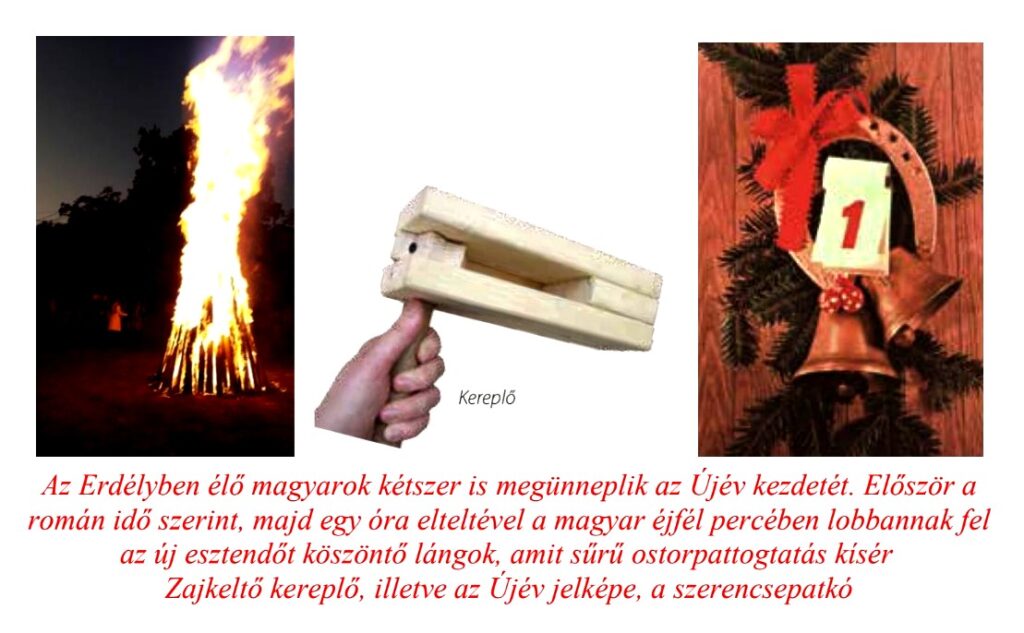
Epiphany
The Epiphany is the event that ends the Christmas holiday cycle on January 6 of the following year. In Hungary, the term water cross originates from the sanctification of water - as one of the most important elements of life. It has three meanings that can be read in the Gospel.
According to the Gospel of Matthew, the first meaning of the Epiphany is the arrival of the three kings and the wise men from the east in Bethlehem, to the baby Jesus, who was given gold, frankincense and myrrh. The three sages - Gáspár, Menyhért and Boldizsár - who are also called magicians, have been a grateful subject of painters and church depictions for centuries.

Another evangelical meaning of the baptismal font is when John - who happened to be Jesus' cousin - baptized Jesus in the water of the Jordan River. The Savior then began his teachings, which he did for three years, until his crucifixion. The scene depicts nothing less than the beginning of the creation of the Christian religion.
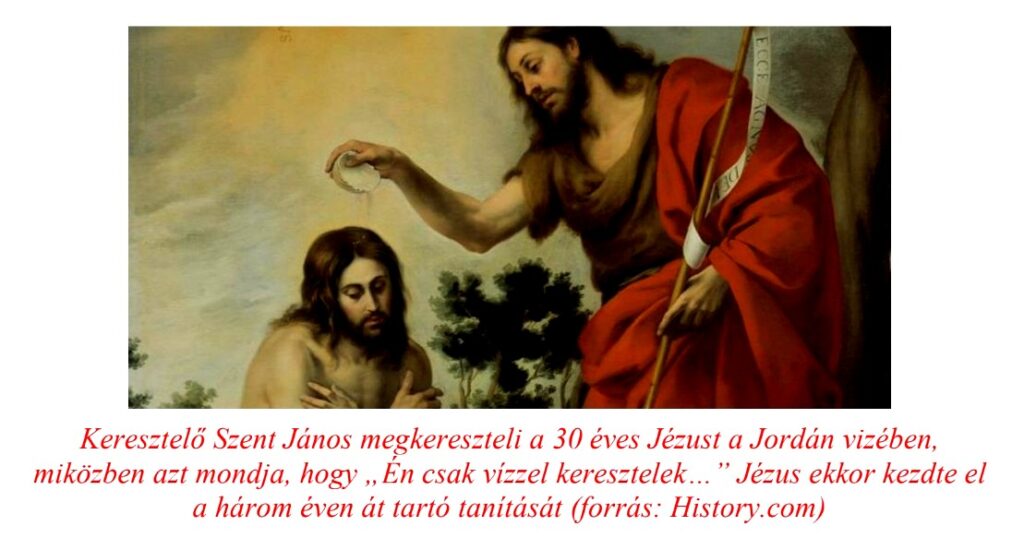
The third meaning of the Epiphany is when Jesus turned the water into wine at the wedding in Cana. This was his first miracle, which he performed at the request of his mother, Mária. Later on, when many customs were associated with it, water consecration was connected with house consecration.
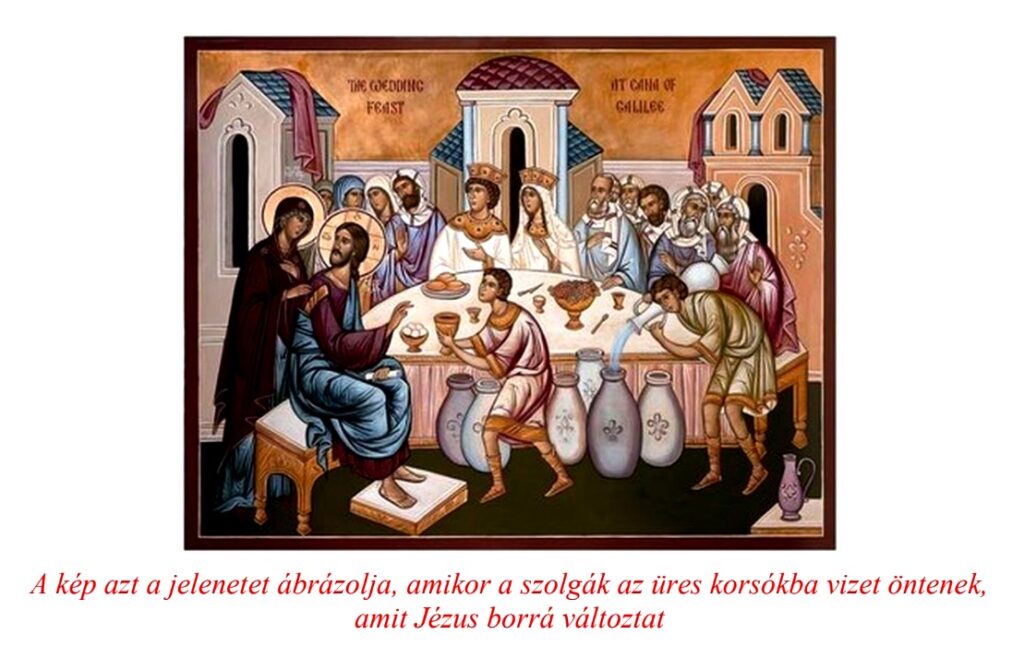
There are many folk customs associated with the water cross, which then opens the carnival season. For example, everything related to life is sprinkled with holy water. The house, the animals, the farmland. Holy water was poured into the bath water of the newborn, the letters G, M, B (Gáspár, Menyhért, Boldizsár) were written on the houses, indicating the royal respect for the Savior.
 Author: Ferenc Bánhegyi
Author: Ferenc Bánhegyi
Cover image: hazipatika.com
The parts of the series published so far can be read here: 1., 2., 3., 4., 5., 6., 7., 8., 9., 10., 11., 12., 13., 14., 15., 16., 17., 18., 19., 20., 21., 22., 23., 24,, 25., 26., 27., 28., 29/1.,29/2., 30., 31., 32., 33., 34., 35., 36., 37., 38., 39., 40., 41., 42., 43., 44., 45., 46., 47., 48., 49., 50., 51., 52., 53., 54., 55., 56., 57., 58., 59., 60.


